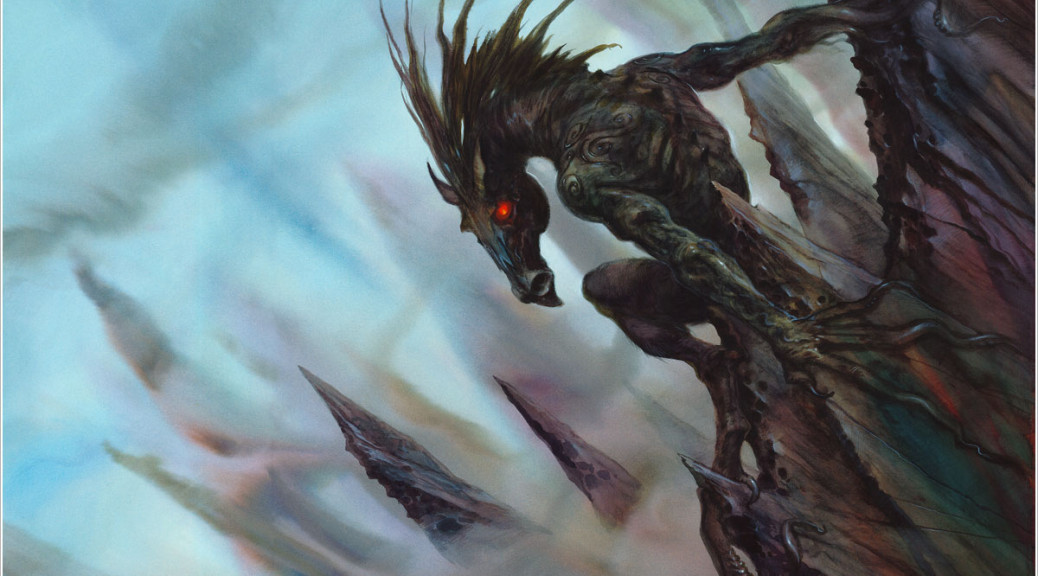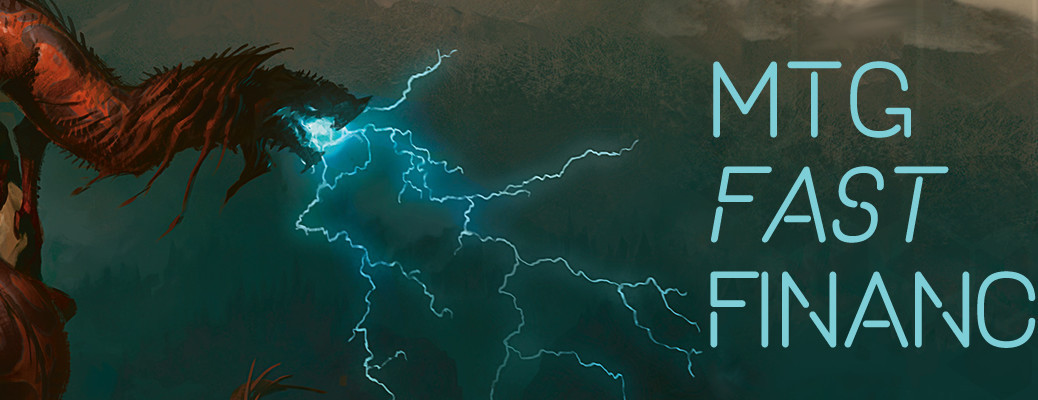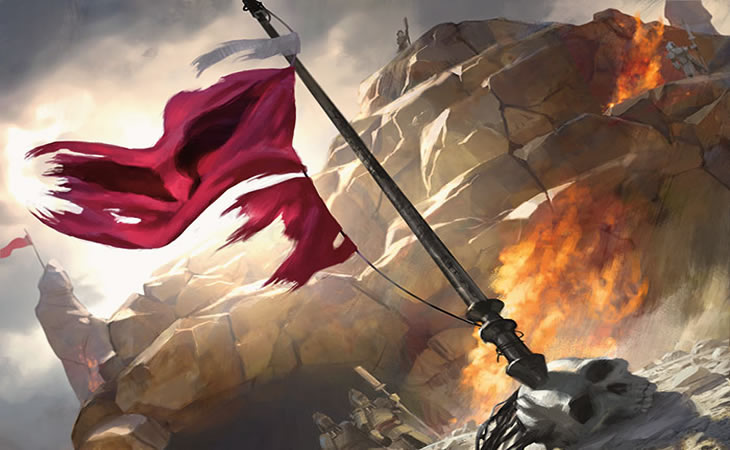By: Travis Allen
@wizardbumpin
Shadows Over Innistrad spoilers started in earnest this week, and they sure are exciting, aren’t they! Archangel Avacyn will shape the combat step for the next 18 months, Relentless Dead may give rise to a new tier one Zombie deck in Standard, and Anguished Unmaking is the closest thing to Vindicate Modern has seen yet. We even got a DFC sorcery, which I’m sure Matt Tabak was thrilled with. Pair all of this with out-of-the-park flavor and atmosphere, and this set is rapidly becoming as popular as our first foray into the horror-trope landscape.
So far the interaction that tickles me the most is between Neglected Heirloom and Heir to Falkenrath.
T1: Neglected Heirloom
T2: Heir to Falkenrath
T3: Equip Heirloom to Heir. Transform Heir by pitching Fiery Temper, which you madness for 1. You’ve now bolted something, are swinging with a 6/5 flying first strike, and still have one mana to spare. On turn three!
Over the next several weeks, we’ll all be wading waist-deep through bloodstained waters. Before we get ahead of ourselves though, I want to check in on what we’re leaving behind: Khans of Tarkir. Last week I looked at how rotation would impact Standard by examining where the holes would be. This week I’ll talk about some specific cards that are quietly slipping into bulk boxes that you should be keeping an eye out for. Make no mistake, these are all long-term plays that aren’t going to pay you off in two months. They will, however, almost definitely pay you off eventually. These are great cards to buy 30 to 200 copies of, shove in a box somewhere, and find again two to five years later and turn them into much more value.

When this was first spoiled, I sort of glazed over the ‘untap’ function of this card. The looting and pumps looked solid, but uninspiring. I mostly ignored it. Then I saw the decklists emerging that utilized the untap with Birds of Paradise, which were four color Glittering Wish builds that could kill on turn two, and I was hooked. It was a unique deck, used a bunch of unique cards that made me some dough (thanks Wish!), and nobody knew what the hell was going on. I loved it. A few weeks later the Fatestitcher build showed up at the Pro Tour, which was considerably better than the garbage fire that was the original iteration’s manabase.
Not long after the deck ate it hard when Treasure Cruise and Dig Through Time were banned. It still pops up occasionally, with some various four-color builds popping up in MTGO leagues since the first of the year, and a Jeskai Ascendancy/Pyromancer’s Ascension hybrid managed to ascend to 15th at GP Bologna two weeks ago. These results are promising, but so far, we aren’t at critical mass. It’s too early to profit on this anyways, as Ascendancies are haven’t undergone the necessary aging yet.
Of all the cards on this list, this may be the one I’m most excited for. Jeskai Ascendancy is out there on the fringes, waiting for the right card to be printed. It’s already established – it was the breakout deck of a Pro Tour – so we know it’s a strong engine. There are still viable builds that occasionally show up at FNM, MTGO, and GP top 64s. The seeds of a new build are there with cards like Visions of Beyond, Glittering Wish, and the relatively new (and Lightning Bolt-proof) Wandering Fumarole. All it really needs is one reasonable-looking card to become completely viable again.
Jeskai Ascendancy is not necessarily the card with the largest potential absolute value today. It is, however, the card with the absolute cheapest buy-in. Right now you can pick up copies for around $.50 to $.60. Hopefully we’ll see this drop off 10 cents or more through rotation. It’s at that time that scooping up a healthy volume will be a strong play. We never know when the right card will come along, or when someone will figure out that the missing piece has been there all along ala Nourishing Shoal, but when it does Ascendancy will see a healthy bump. We saw prices in the $3 to $6 range when it was all the rage, and with two years worth of attrition, it could easily surpass that with a new enabler.

Boy, this card has just been a roller coaster. It was $1. Then it was $.50. Then it was $1.50. Then it was $3, then $8, then $2. The buylist has tracked similarly.
On release, every finance writer worth his salt did a double take. Doubling Season is the banner card for casuals loving counters. Hardened Scales evokes the same mental imagery, and with a teeny tiny converted mana cost, there’s even a glimmer of constructed legitimacy. What a financial windfall that could be!
Late last year this card saw a stupendous rise in price, jumping from about $1.50 to nearly $8. It took almost four months to find it’s way back to a $2 price tag, so there had to be at least a few people buying in between. It was in part predicated on tournament success, whether real or imagined, but that price spike was given backbone by the idea that there’s a casual market for the card as well. Cards with a similar effect that have greater mana costs and were utter garbage in Standard have done well (Parallel Lives) so why can’t Scales? Recently the ChannelFireball team showed up to an event with Scales in their sleeves. They didn’t take the event down, but it did remind everyone that the effect is potentially explosive in real formats.
Over the coming years, many, many casual decks will be built with this card at the core. Do you know what the first deck I bought cards for online was? It was a Simic counter-based Doubling Season deck with stuff like Cytoshape and Cytoplast Root-Kin. Month by month, supply on Scales is going to drain to attrition, and with no new copies entering the market, prices will quietly begin to rise. In fact, did you catch the uptick at the end of the graph there? The retail price has only barely started to budge since early December of last year, with the MTGPrice having climbed from $2 to today’s $2.32. The buylist though? $.25 on December 9th, and $1.06 today. That’s a 15% gain in the retail price, and a 400% gain in buylist. That is very real organic demand, and in three years, you’re going to wish you had bought more of these.
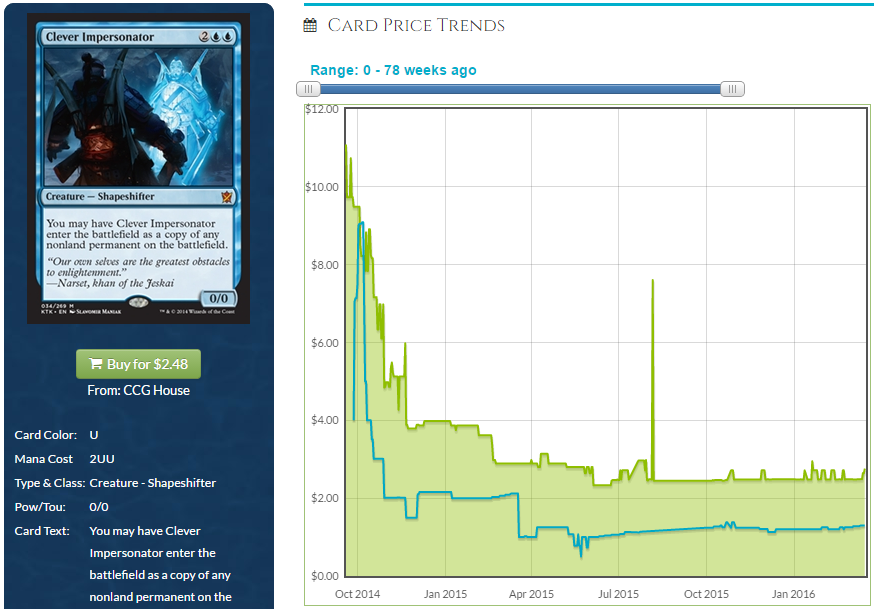
Clone effects are popular, especially so in EDH. Do you know what’s almost always a great card to cast in a multiplayer game? A four mana copy of the best thing on the battlefield. It’s even sillier when you can bounce that four mana creature to your hand and do it again. Beads? BEES.
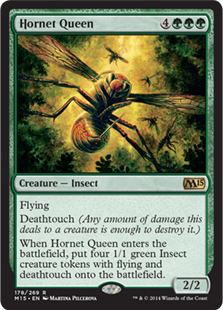
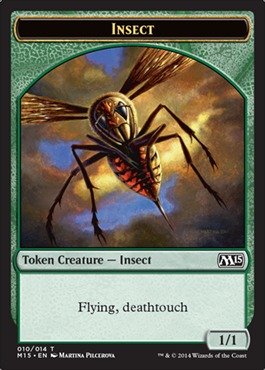
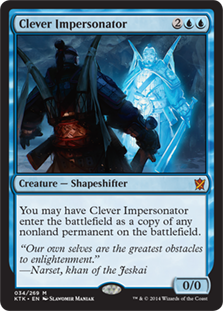
Of course, Clever Impersonator doesn’t bounce itself, but whatever. What makes it special is that not only can it come down as the best creature on the board, it can also come down as the best artifact, or the best enchantment, or Planeswalker, or equipment. Whatever. Falling behind in life and need a Batterskull? Yep, it does that. Would the tutor on that Ob Nixilis Reignited be especially useful in your mono-blue deck? Go for it. How about a Nevinyrral’s Disk? Done. And. Done.
We’ve see clone effects gain over time more than once. Phantasmal Image is the best known of the bunch, though admittedly that’s partly because of the raw value in a two mana clone. Then there’s Sculpting Steel. Copy Enchantment. Phyrexian Metamorph. Progenitor Mimic. Sakashima the Impostor. The list goes on. As long as the copy effect is useful, reasonably costed, and/or versatile, there’s demand for it. Clever Impersonator checks off every one of those boxes.
Clever Impersonator started life with a retail price of $10 (and a buylist of $9!), so clearly there was an expectation and belief that it’s a powerful card. The foil is also about four times higher than the non-foil, which means the EDH crowd is into this card. Today the price tag is around $2, which is about $1 more than I’d really like it to be, but there’s still fertile ground here. I’m not as excited to rush out and spend cash on these – I’d rather do that on Jesaki Ascendancy or Hardened Scales – but I’d be trading for every copy I could find.
These are cards that stand out to me as exceptional pickups for the future. Whether it’s based on casual appeal, a powerful and consistent upward force on card prices, or as a potential constructed combo breakout, which can stick a rocket right into a card’s butt and blast it to the money moon, I expect these to pay off a few years down the road. I’m sure there are other cards in Khans of Tarkir and Fate Reforged that I didn’t pick that you guys think stand to gain handsomely. Share them with us in the comments!

